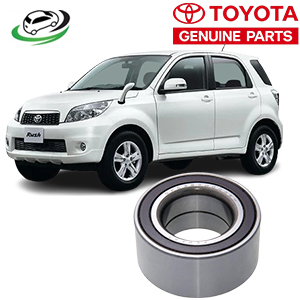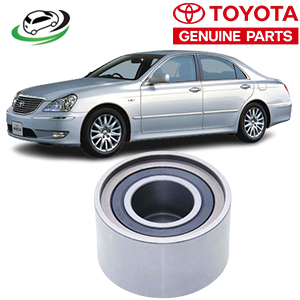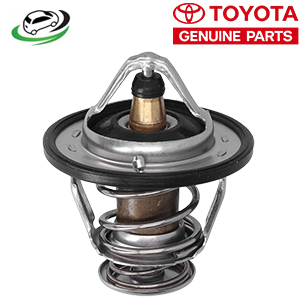-13%
Get Genuine Thermostat Assy For 1KD/ 2KD/ 1KZ Engines 90916 03118
The thermostat assembly (often referred to as the thermostat housing assembly) is an essential part of a vehicle’s cooling system, responsible for regulating the engine’s temperature. It plays a crucial role in ensuring that the engine operates within the optimal temperature range. When functioning correctly, the thermostat ensures the engine warms up quickly, prevents it from overheating, and maintains fuel efficiency and performance. This detailed guide will explore the components, functions, types, benefits, signs of wear, and maintenance tips for thermostat assemblies.
The Function of a Thermostat Assembly
The primary function of the thermostat assembly is to regulate the flow of coolant between the engine and the radiator. When the engine is cold, the thermostat remains closed to allow the engine to reach its operating temperature more quickly. Once the engine reaches this optimal temperature (usually around 85°C to 95°C or 185°F to 200°F), the thermostat opens, allowing coolant to flow to the radiator to prevent overheating.
The process works as follows:
- Engine Warm-Up: When you start your vehicle, the engine is cold, and the thermostat remains closed. This traps the coolant inside the engine, allowing it to warm up faster. A quick warm-up is essential for reducing engine wear, improving emissions, and optimizing fuel consumption.
- Thermostat Opens: As the engine reaches its optimal operating temperature, the thermostat opens, allowing the hot coolant to flow through the radiator, where it is cooled before circulating back to the engine.
- Thermostat Closes: If the coolant temperature drops too much (below the optimal range), the thermostat closes again to maintain the right temperature balance.
The thermostat constantly adjusts the flow of coolant to ensure that the engine maintains a stable and efficient operating temperature. This is critical because an engine that runs too cold can be inefficient and suffer increased wear, while an engine that runs too hot can overheat and cause severe damage.
Components of a Thermostat Assembly
The thermostat assembly consists of several components working together to regulate the coolant flow:
- Thermostat Valve: The main component, a small, heat-sensitive valve that opens or closes based on the coolant temperature. It contains a wax pellet that expands when heated, forcing the valve open.
- Thermostat Housing: This is the cover or casing that holds the thermostat valve and connects it to the engine and radiator hoses. The housing directs the flow of coolant and is typically made of metal or plastic.
- Gasket or Seal: This component ensures that the connection between the thermostat housing and engine is leak-proof. It prevents coolant from leaking out of the system, which would lead to a loss of pressure and efficiency.
- Temperature Sensor (in some modern systems): Many modern vehicles have a temperature sensor integrated into the thermostat assembly. This sensor provides feedback to the vehicle’s electronic control unit (ECU) about the coolant temperature, allowing for more precise control of engine performance and emissions.
- Bypass Valve (in some designs): Some thermostat assemblies have a bypass valve that allows coolant to flow in a smaller loop when the thermostat is closed, helping to maintain a steady flow of coolant within the engine even when it’s warming up.
Types of Thermostat Assemblies
There are different types of thermostat assemblies, each designed to suit specific vehicle applications. The most common types include:
- Traditional Mechanical Thermostats
- Function: These use a wax pellet that melts at a specific temperature to open the thermostat valve. As the wax heats up, it expands, pushing a plunger that opens the valve.
- Benefits: Mechanical thermostats are simple and reliable, making them widely used in many vehicles.
- Drawbacks: They can be slower to react to temperature changes, especially in extreme conditions, and are less precise compared to newer technologies.
- Electronically Controlled Thermostats
- Function: These thermostats use a combination of mechanical operation and electronic control. An electric heating element works in conjunction with the wax pellet to provide faster, more precise temperature control.
- Benefits: Electronically controlled thermostats can respond quickly to engine and environmental conditions, improving fuel efficiency, reducing emissions, and enhancing performance.
- Drawbacks: They are more complex and costly to replace compared to mechanical thermostats.
- Fail-Safe Thermostats
- Function: These are designed to fail in the open position, allowing coolant to continue circulating if the thermostat malfunctions. This helps prevent engine overheating in the event of a failure.
- Benefits: Provides added protection against engine damage due to overheating.
- Drawbacks: In the event of failure, the engine may run cooler than optimal, leading to reduced efficiency and performance until the thermostat is replaced.
Benefits of a Properly Functioning Thermostat Assembly
- Improved Fuel Efficiency: The thermostat ensures that the engine reaches and maintains the optimal operating temperature. This helps improve fuel combustion efficiency, reducing fuel consumption and emissions.
- Enhanced Engine Performance: A well-regulated engine temperature ensures that the engine runs smoothly and delivers consistent power. The right temperature balance minimizes engine wear and maximizes performance.
- Prevention of Overheating: By regulating coolant flow to the radiator, the thermostat prevents the engine from overheating, which could cause severe engine damage.
- Faster Warm-Up: The thermostat’s ability to close when the engine is cold allows the engine to warm up quickly. This reduces wear on engine components during cold starts and helps get the vehicle’s heater working faster in colder conditions.
- Environmental Benefits: By ensuring the engine runs at the correct temperature, the thermostat helps reduce harmful emissions, contributing to a cleaner environment.
Signs of a Failing Thermostat Assembly
A malfunctioning thermostat assembly can lead to several issues, from poor engine performance to serious engine damage. Here are some common signs of a failing thermostat:
- Engine Overheating: One of the most obvious signs is engine overheating. If the thermostat fails to open, coolant won’t flow to the radiator, causing the engine to overheat.
- Coolant Leaks: If you notice coolant leaking around the thermostat housing, it could be due to a faulty gasket or a cracked housing.
- Erratic Temperature Gauge Readings: A failing thermostat can cause the temperature gauge to fluctuate erratically. The engine may overheat and cool down repeatedly if the thermostat opens and closes inconsistently.
- Cold Engine for Extended Periods: If the thermostat is stuck in the open position, the engine may take too long to warm up, or it may never reach the optimal temperature. This can result in poor fuel efficiency and reduced engine performance.
- Poor Heater Performance: If the thermostat is stuck open and the engine isn’t warming up properly, the vehicle’s heater may not work efficiently, especially in colder climates.
Maintenance Tips for Thermostat Assemblies
Maintaining the thermostat assembly is crucial for the health of your engine and cooling system. Here are some tips to ensure its longevity and proper functioning:
- Regular Coolant System Inspection: During routine maintenance, have the coolant system, including the thermostat assembly, inspected for leaks, corrosion, and proper function.
- Coolant Flushes: Periodically flushing and replacing the coolant ensures that the system remains clean and free of debris that could clog the thermostat or damage other components.
- Check for Coolant Leaks: Keep an eye out for any signs of coolant leaks around the thermostat housing or under the vehicle. Leaks can lead to a loss of coolant pressure and inefficient cooling.
- Replace Thermostat During Major Repairs: If you’re replacing other major components in the cooling system, such as the radiator or water pump, it’s a good idea to replace the thermostat at the same time to ensure the system operates smoothly.
- Monitor Engine Temperature: Pay attention to your vehicle’s temperature gauge. If you notice any unusual fluctuations or signs of overheating, have the thermostat inspected as it may be the root cause.
Conclusion
The thermostat assembly is a small but critical part of your vehicle’s cooling system, ensuring that the engine operates within the ideal temperature range. Whether mechanical or electronic, a well-functioning thermostat improves fuel efficiency, performance, and longevity while preventing engine overheating or excessive wear. Regular inspection and maintenance of the thermostat assembly, along with prompt replacement when signs of failure appear, are essential for maintaining optimal engine health.
By understanding the role of the thermostat assembly and its impact on your vehicle’s performance, you can ensure that your engine remains efficient, reliable, and safe on the road.
Follow us on Facebook for more parts.




Reviews
Clear filtersThere are no reviews yet.